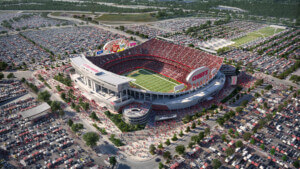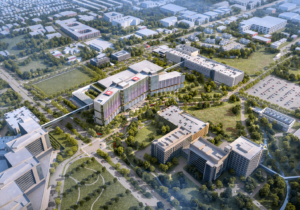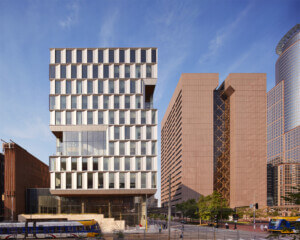Death Star. The Bird Killer. Jawa Sandcrawler. The Spank. Skulldome. The Dark Crystal. Black Bullfrog. Banks a Billion.
Since the design for the U.S. Bank Stadium in Minneapolis was unveiled in May 2013, the black zinc, glass, and ETFE-paneled angular structure by HKS Architects has inspired a plethora of derogatory nicknames. Fueling the disparagement has been the sports team itself, which has been engaged since groundbreaking occurred on the 75,000-seat, 1.75-million-square-foot facility, in one public-relations fiasco after another on a level befitting a parody in The Onion.
In May 2012, the Minnesota state legislature signed a bill calling for a $975 million multipurpose stadium to be built for the Minnesota Vikings football team on the former site of the Hubert H. Humphrey Metrodome on the east side of downtown Minneapolis. Across the state, citizens groaned: another taxpayer-funded stadium built for millionaires. To date, the cost to state and local taxpayers is close to $498 million, with the total cost of the stadium slated at $1.1 billion.
In 2013, after the design was unveiled, Audubon Minnesota called the structure a “death trap” for birds due to its 200,000 square feet of transparent glass. Local bird enthusiast Howard Miller painted a grim picture in the local newspaper, the Star Tribune. Miller “raised the specter of dead indigo buntings and ruby-throated hummingbirds ‘thwacking’ against the glass, falling to the ground and lying lifeless on the sidewalk as purple-clad masses arrived for the games.” The Minnesota Sports Facilities Authority, involved in building the stadium, declined to replace the glass with a less-deadly fritted version due to costs and delays.
Meanwhile, the stadium’s construction began spurring development in an urban area that had been largely occupied by surface parking lots. Renamed Downtown East or East Town, the area filled with cranes and workers constructing apartment and condo buildings, a park, and Wells Fargo office towers. Proponents of the stadium talked up how the project was contributing a much-needed economic boost to Minneapolis in jobs via new construction, new and existing restaurants and bars, new hotels, and new retail.
Then the “photo bomb” incident occurred: The Minnesota Vikings organization sued Wells Fargo over two signs on its new office towers “that permanently ‘photo bomb’ the images of the iconic U.S. Bank Stadium,” the lawsuit stated. In January of this year, a U.S. district judge allowed the Vikings to proceed with the lawsuit. Then the Vikings applied to have Chicago Avenue, which runs for three blocks in front of the stadium, renamed “Vikings Way” due to the team’s aversion to a street address that evokes a division rival. Minneapolis City Hall would not budge on the street name, and the Vikings eventually withdrew the application.
There was also the dispute over $16 million in cost overruns that had to be settled with Mortenson Construction (and there’s yet to be a final tally) and a leak in the snow gutters at the top of the building requiring nearly $4 million in repairs. Lastly, the Vikings announced a “distinct monument”: A Viking ship–themed sculpture with an LED screen for a sail on the plaza outside the stadium (by RipBang Studios, a California-based division of the Minneapolis design firm Nelson), as well as The Horn sculpture (by the Minneapolis-based Alliiance) inside—both drew criticism from the local arts community.
What’s done is done. In August, the Vikings kick off the first game in the new stadium. The structure is more than twice as big as the Metrodome. The first row of seats is a mere 41 feet away from the sideline, and the field seats get fans even closer at 25 feet. The wi-fi network is capable of accommodating upward of 30,000 fans as well as vendors and staff. While fully enclosed, the stadium’s vast expanses of roof, wall, and clerestory glass provide a feeling of openness.
Whether viewed on foot, car, or from a seat on the Blue Line of the light-rail train, it’s easy to see how the building meshes with surrounding streets amid the fast-changing, rebranded Downtown East neighborhood. To what extent the stadium is a game changer for the City of Minneapolis, and the economic and cultural life of the area, however, remains to be seen.










